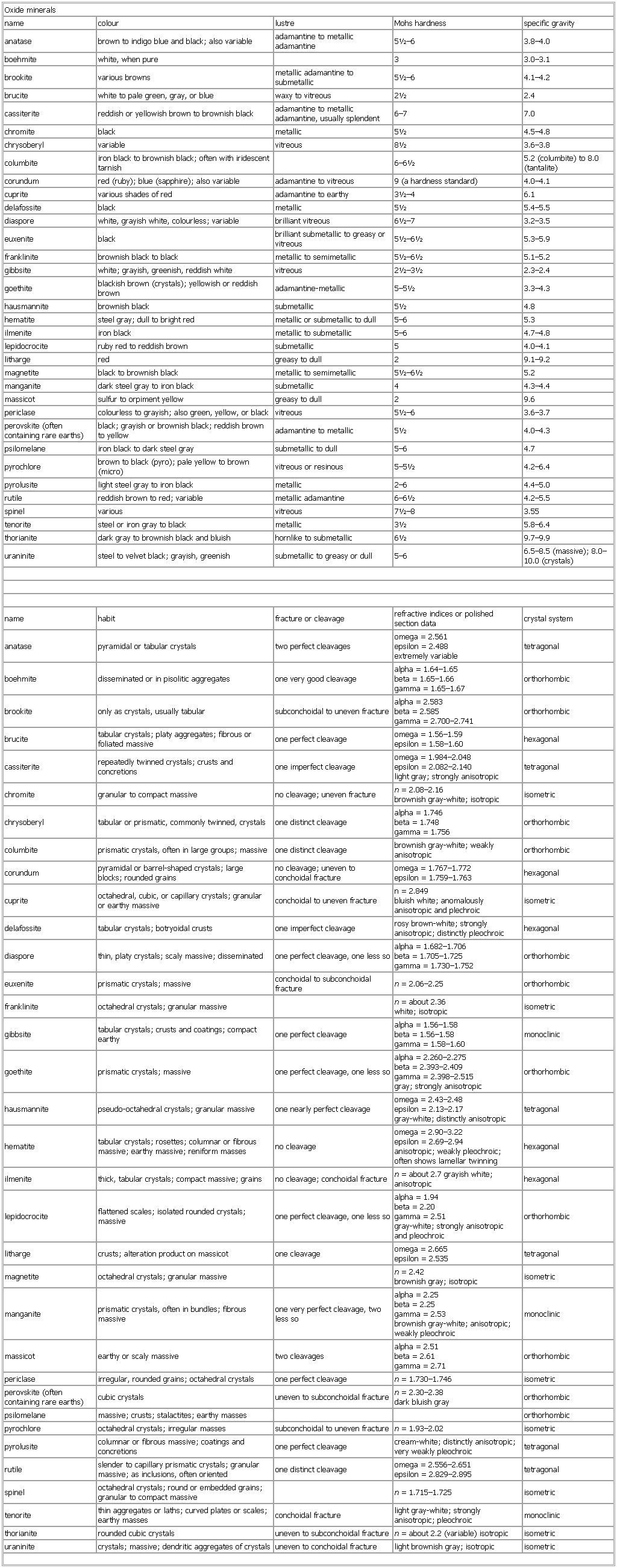- Oxide minerals
-
▪ TableOxide mineralsname colour lustre Mohs hardness specific gravityanatase brown to indigo blue and black; also variable adamantine to metallic adamantine 5½–6 3.8–4.0boehmite white, when pure 3 3.0–3.1brookite various browns metallic adamantine to submetallic 5½–6 4.1–4.2brucite white to pale green, gray, or blue waxy to vitreous 2½ 2.4cassiterite reddish or yellowish brown to brownish black adamantine to metallic adamantine, usually splendent 6–7 7.0chromite black metallic 5½ 4.5–4.8chrysoberyl variable vitreous 8½ 3.6–3.8columbite iron black to brownish black; often with iridescent tarnish 6–6½ 5.2 (columbite) to 8.0 (tantalite)corundum red (ruby); blue (sapphire); also variable adamantine to vitreous 9 (a hardness standard) 4.0–4.1cuprite various shades of red adamantine to earthy 3½–4 6.1delafossite black metallic 5½ 5.4–5.5diaspore white, grayish white, colourless; variable brilliant vitreous 6½–7 3.2–3.5euxenite black brilliant submetallic to greasy or vitreous 5½–6½ 5.3–5.9franklinite brownish black to black metallic to semimetallic 5½–6½ 5.1–5.2gibbsite white; grayish, greenish, reddish white vitreous 2½–3½ 2.3–2.4goethite blackish brown (crystals); yellowish or reddish brown adamantine-metallic 5–5½ 3.3–4.3hausmannite brownish black submetallic 5½ 4.8hematite steel gray; dull to bright red metallic or submetallic to dull 5–6 5.3ilmenite iron black metallic to submetallic 5–6 4.7–4.8lepidocrocite ruby red to reddish brown submetallic 5 4.0–4.1litharge red greasy to dull 2 9.1–9.2magnetite black to brownish black metallic to semimetallic 5½–6½ 5.2manganite dark steel gray to iron black submetallic 4 4.3–4.4massicot sulfur to orpiment yellow greasy to dull 2 9.6periclase colourless to grayish; also green, yellow, or black vitreous 5½–6 3.6–3.7perovskite (often containing rare earths) black; grayish or brownish black; reddish brown to yellow adamantine to metallic 5½ 4.0–4.3psilomelane iron black to dark steel gray submetallic to dull 5–6 4.7pyrolusite light steel gray to iron black metallic 2–6 4.4–5.0rutile reddish brown to red; variable metallic adamantine 6–6½ 4.2–5.5spinel various vitreous 7½–8 3.55tenorite steel or iron gray to black metallic 3½ 5.8–6.4thorianite dark gray to brownish black and bluish hornlike to submetallic 6½ 9.7–9.9uraninite steel to velvet black; grayish, greenish submetallic to greasy or dull 5–6 6.5–8.5 (massive); 8.0–10.0 (crystals)name habit fracture or cleavage refractive indices or polished section data crystal systemanatase pyramidal or tabular crystals two perfect cleavages omega = 2.561epsilon = 2.488extremely variable tetragonalboehmite disseminated or in pisolitic aggregates one very good cleavage alpha = 1.64–1.65beta = 1.65–1.66gamma = 1.65–1.67 orthorhombicbrookite only as crystals, usually tabular subconchoidal to uneven fracture alpha = 2.583beta = 2.585gamma = 2.700–2.741 orthorhombicbrucite tabular crystals; platy aggregates; fibrous or foliated massive one perfect cleavage omega = 1.56–1.59epsilon = 1.58–1.60 hexagonalcassiterite repeatedly twinned crystals; crusts and concretions one imperfect cleavage omega = 1.984–2.048epsilon = 2.082–2.140light gray; strongly anisotropic tetragonalchromite granular to compact massive no cleavage; uneven fracture n = 2.08–2.16brownish gray-white; isotropic isometricchrysoberyl tabular or prismatic, commonly twinned, crystals one distinct cleavage alpha = 1.746beta = 1.748gamma = 1.756 orthorhombiccolumbite prismatic crystals, often in large groups; massive one distinct cleavage brownish gray-white; weakly anisotropic orthorhombiccorundum pyramidal or barrel-shaped crystals; large blocks; rounded grains no cleavage; uneven to conchoidal fracture omega = 1.767–1.772epsilon = 1.759–1.763 hexagonalcuprite octahedral, cubic, or capillary crystals; granular or earthy massive conchoidal to uneven fracture n = 2.849bluish white; anomalously anisotropic and plechroic isometricdelafossite tabular crystals; botryoidal crusts one imperfect cleavage rosy brown-white; strongly anisotropic; distinctly pleochroic hexagonaldiaspore thin, platy crystals; scaly massive; disseminated one perfect cleavage, one less so alpha = 1.682–1.706beta = 1.705–1.725gamma = 1.730–1.752 orthorhombiceuxenite prismatic crystals; massive conchoidal to subconchoidal fracture n = 2.06–2.25 orthorhombicfranklinite octahedral crystals; granular massive n = about 2.36white; isotropic isometricgibbsite tabular crystals; crusts and coatings; compact earthy one perfect cleavage alpha = 1.56–1.58beta = 1.56–1.58gamma = 1.58–1.60 monoclinicgoethite prismatic crystals; massive one perfect cleavage, one less so alpha = 2.260–2.275beta = 2.393–2.409gamma = 2.398–2.515gray; strongly anisotropic orthorhombichausmannite pseudo-octahedral crystals; granular massive one nearly perfect cleavage omega = 2.43–2.48epsilon = 2.13–2.17gray-white; distinctly anisotropic tetragonalhematite tabular crystals; rosettes; columnar or fibrous massive; earthy massive; reniform masses no cleavage omega = 2.90–3.22epsilon = 2.69–2.94anisotropic; weakly pleochroic; often shows lamellar twinning hexagonalilmenite thick, tabular crystals; compact massive; grains no cleavage; conchoidal fracture n = about 2.7 grayish white; anisotropic hexagonallepidocrocite flattened scales; isolated rounded crystals; massive one perfect cleavage, one less so alpha = 1.94beta = 2.20gamma = 2.51gray-white; strongly anisotropic and pleochroic orthorhombiclitharge crusts; alteration product on massicot one cleavage omega = 2.665epsilon = 2.535 tetragonalmagnetite octahedral crystals; granular massive n = 2.42brownish gray; isotropic isometricmanganite prismatic crystals, often in bundles; fibrous massive one very perfect cleavage, two less so alpha = 2.25beta = 2.25gamma = 2.53brownish gray-white; anisotropic; weakly pleochroic monoclinicmassicot earthy or scaly massive two cleavages alpha = 2.51beta = 2.61gamma = 2.71 orthorhombicpericlase irregular, rounded grains; octahedral crystals one perfect cleavage n = 1.730–1.746 isometricperovskite (often containing rare earths) cubic crystals uneven to subconchoidal fracture n = 2.30–2.38dark bluish gray orthorhombicpsilomelane massive; crusts; stalactites; earthy masses orthorhombicpyrochlore octahedral crystals; irregular masses subconchoidal to uneven fracture n = 1.93–2.02 isometricpyrolusite columnar or fibrous massive; coatings and concretions one perfect cleavage cream-white; distinctly anisotropic; very weakly pleochroic tetragonalrutile slender to capillary prismatic crystals; granular massive; as inclusions, often oriented one distinct cleavage omega = 2.556–2.651epsilon = 2.829–2.895 tetragonalspinel octahedral crystals; round or embedded grains; granular to compact massive n = 1.715–1.725 isometrictenorite thin aggregates or laths; curved plates or scales; earthy masses conchoidal fracture light gray-white; strongly anisotropic; pleochroic monoclinicthorianite rounded cubic crystals uneven to subconchoidal fracture n = about 2.2 (variable) isotropic isometricuraninite crystals; massive; dendritic aggregates of crystals uneven to conchoidal fracture light brownish gray; isotropic isometricSee as table:

* * *
Universalium. 2010.
